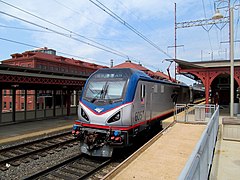Amtrak paint schemes

Amtrak has used a variety of liveries on its rolling stock since taking over intercity passenger rail service in the United States in 1971. A series of seven schemes termed Phases, first introduced in 1972, have seen the widest use. Phases primarily use geometric arrangements of red, white, and blue—the national colors of the United States—part of Amtrak's patriotic visual identity.
Amtrak began operations in May 1971 with a mixture of equipment still painted in the distinct colored liveries of the freight railroads that relinquished their passenger service to Amtrak. Amtrak picked and chose equipment that it determined to be in the best condition, and elected not to keep the same rolling stock on the same routes. Since this resulted in trains with mismatched liveries, which contrasted with the previous coordinated liveries, that period was later known as the Rainbow Era.
To build the brand of Amtrak as a unified passenger railroad, the rolling stock was gradually repainted into a new system-wide livery starting around 1972. Successive liveries are known as Phases and are sequentially numbered using Roman numerals – a nomenclature that began with model railroaders and was later officially adopted by Amtrak. Most current locomotives use the 2000-introduced Phase V, while passenger cars use the 2002-introduced Phase VI. A modified Phase III scheme was introduced for some equipment in 2013. Non-revenue equipment uses bright lime green or a variation of Phase V.
Some routes financially supported by individual states use service-specific liveries to provide a more regionalized distinction. The three routes under the Amtrak California branch—the Capitol Corridor, Pacific Surfliner, and San Joaquin—use equipment painted in several custom schemes, as do the Cascades and Piedmont. Locomotives for the eight Amtrak Midwest services also use a custom scheme, with a matching scheme planned for under-construction passenger cars.
Amtrak has repainted equipment in unique livery for special uses, including its 40th anniversary in 2011 and to promote the Operation Lifesaver safety campaign. Equipment has also been wrapped for advertising promotions. When testing equipment from other railroads, Amtrak has mostly kept existing livery, though some longer-term tests used Phase schemes.
Rainbow Era[]
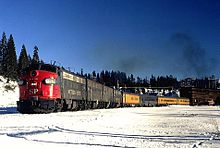
When Amtrak took over intercity passenger rail service on May 1, 1971, it inherited a collection of rolling stock from twenty different railroads, each with its own distinct colors and logos.[1] Needing only to operate 184 of the 366 trains that had been run nationwide by the private railroads, Amtrak was able to pick the 1,200 best passenger cars to lease from the 3,000 that the private railroads had owned.[2] This equipment was haphazardly mixed to form consists, resulting in trains with the mismatched colors of several predecessor railroads. This "Rainbow Era" was short-lived; Amtrak began purchasing some of the leased equipment in mid-1971, setting the stage for wholesale repainting from 1972 to 1974.[3]
Phase paint schemes[]
The Phase paint schemes have been used on most passengers equipment – locomotives, passenger cars, and trainsets – as well as some non-passenger cars and non-revenue equipment. Phase schemes generally have red, white, and blue on the sides of equipment, with black or gray sections around the wheels and roof to hide grime.[4]
Phase I[]
Introduced in 1972, Phase I was the first paint scheme to be implemented system-wide on Amtrak's trains.[5] Except for a small number of locomotives that had been painted into experimental and promotional paint schemes, it was the first new paint for most equipment under Amtrak.[5] The scheme was part of Amtrak's larger move to a visual identity featuring the national colors of red, white, and blue.[6] Amtrak did not assign nomenclature for its livery; model railroaders began referring to this first paint scheme as Phase I and numbering all subsequent phases sequentially using Roman numerals. Amtrak later made the Phase numbering scheme the official terminology.[7]
Locomotives were painted a light gray ("Platinum Mist") with a black roof, the Amtrak "Pointless Arrow" chevron logo on the side, and a red nose (which led to a "Bloody Nose" nickname).[5][8] Passenger cars were silver (or left bare stainless steel), with a red and bright blue stripe (bracketed by thin white stripes) at window level and the chevron logo at one or both ends.[5] A number of variants were made for non-revenue locomotives, GG1 locomotives, Turbotrain and Turboliner trainsets, and self-propelled RDC and Metroliner railcars.[5]

An EMD FP7 and two EMD SDP40Fs in 1975

A Turboliner trainset in 1975

A circa-1975 postcard of an Amfleet I passenger car
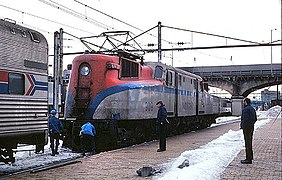
A GG1 locomotive in 1978
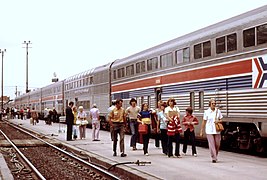
Hi-Level passenger cars in 1974
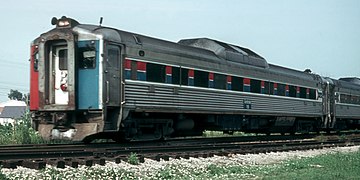
Rail Diesel Cars in 1975

TurboTrain in 1974
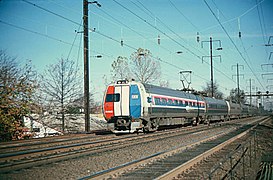
Metroliners in 1975
Phase II[]
The Phase II paint scheme was introduced in late 1974 with the arrival of the new GE E60 locomotives.[9] The red nose and chevron logo on locomotives were replaced with stripes similar to passenger cars. Most passenger cars were essentially unchanged from Phase I, except for the removal of the chevron logo; new Sightseer lounges had a higher stripe with an angled transition on each end.[5]

GE E60 locomotive in 1980

Metroliners in 1980

Superliner passenger cars in 1985
Phase III[]
Phase III, introduced in 1976, is still used on some equipment. On both passenger cars and locomotives, the outer white pinstripes were removed while the inner stripe was widened, resulting in red, white, and blue stripes of equal width. Turboliners and the LRC test train were painted in white, with the stripes at the bottom of the train.[5] This scheme was introduced "for safety, graphic aid and saving money", as the white band was highly reflective and provided a place for car information, and the standard widths made better use of raw material.[10]
Several types of locomotives that were acquired later were given variations on Phase III. AEM-7 locomotives had the blue stripe expanded to cover the entire lower part of the body.[5] On Dash 8-32BWH locomotives, a deeper blue and red was used; the stripes had additional pinstripes and angled upward across the middle of the body.[5] The similarity to the Pepsi logo led to the units being nicknamed "Pepsi Cans".[11][12]: 108 Genesis locomotives had a lighter roof and narrower white stripe; the stripes angled downward on the sloped nose, and faded towards the rear.[5] That variant was created by industrial designer Cesar Vergara, who also designed the angular bodies of the locomotives.[12]: 111
In October 2013, Amtrak introduced a new variant of Phase III with the production of the new Viewliner II cars, the first of which entered service in 2015.[13] The Viewliner cars have some changes from previous Phase III passenger cars, including a red reflective stripe at the bottom and a newer ("Travelmark") logo.[5] In January 2016, Amtrak revealed a P32AC-DM that was repainted into Phase III, similar to that of the heritage units Nos. 145 and 822, but featuring modern logos and "Empire Service" emblems on the sides. All P32AC-DMs were repainted into this scheme, with costs shared between Amtrak and the state of New York.[14]

P30CH locomotive in 1987

P32-8BWH locomotive in "Pepsi Can" livery in 1992

Class RTL Turboliner trainset in 1984

AEM-7 locomotive in 1987

P40DC locomotive in 1993
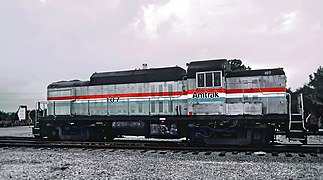
RS3M work locomotive in 1987
Heritage Fleet dome car "Ocean View" in 2016
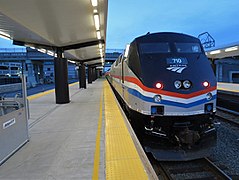
P32AC-DM locomotive in 2017
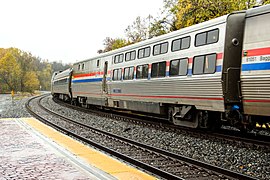
Viewliner II diner in 2017
Phase IV[]
Beginning in 1993, Phase IV was introduced as a striking departure from the traditional red, white, and blue style seen previously. Brought into service with the delivery of the newer Superliner II cars, Phase IV has two thin red stripes and a thick dark blue stripe.[5] In 1997, Amtrak extended the scheme to locomotives, initially GE P42DC diesel locomotives on Northeast Corridor services.[15]

Superliner passenger cars in 1998

P42DC locomotive in 2001
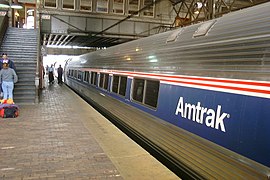
Amfleet I passenger cars in 2002

NortheastDirect branding in the 1990s
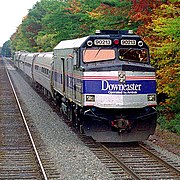
NPCU in 2005
Phase V[]
Phase V was introduced with the arrival of the Acela Express high-speed train sets in 2000 and is currently used on most locomotives.[5] Locomotives are painted light gray, with a blue stripe (darker than Phases I–III, but lighter than IV) at the top and a thin red reflective sill stripe at the bottom. The blue stripe has a wavy bottom on Genesis locomotives and Acela Express power cars, and a flat bottom on other locomotives and ex-F40PH non-powered control units (NPCUs). The Amtrak "Travelmark" logo is painted near the front or rear of the unit.[5]
Acela Express trainsets have grey and stainless steel bodies with the lower red stripe, with the blue roof and Acela logo on the power cars only. The Acela passenger cars have no blue stripe; colored shapes called "mobiles", based on the shape of the Acela logo, are used to indicate the type of car (Business Class, Cafe Bistro, or First Class).[5] A similar scheme was created for Amfleet coaches used on the Acela Regional, with a window stripe (light blue for Coach Class and baggage cars, blue for Business Class and cafe cars) and mobiles to indicate the type of service.[5] The rebuilt Turboliners also had a version of the Phase V livery, with similar window stripes and mobiles.[5][12]: 153
Non-passenger cars like Auto Train auto racks are all-gray except for the logo and red stripe; Express Box Cars had blue stripes on top and bottom.[5]
Acela Express trainset in 2012

HHP-8 locomotive (with Acela logo) and Amfleet I passenger cars in Phase V livery in 2002

P42DC locomotive in 2007
ACS-64 locomotive in 2014

Express Box Cars in 2001

MP14B switcher in 2018
Phase VI[]
Phase VI (also commonly referred to as Phase IVb) was introduced in 2002, and is currently used on most passenger cars.[5] It retains the same stripe style as Phase IV: wide window stripes on single-level cars, and narrow stripes on Superliners. The red reflective sill stripe and mid-tone blue on Phase V are used. Single-level cars have white logos within the blue stripe, while Superliners have blue logos below the stripes.[5]
Five of the first six Siemens Charger ALC-42 locomotives will have a "transitional" Phase VI scheme consisting of a mostly blue body with red and black around the windshield, and a red and silver chevrons at the rear.[16]

Superliner I dining car in 2006
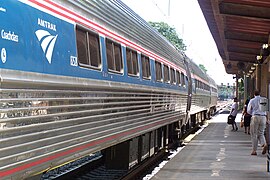
Amfleet I passenger cars in 2007
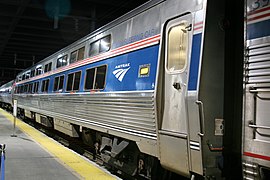
Viewliner I sleeping car in 2008
Phase VII[]
Phase VII will be introduced in 2021 as the new livery for most Amtrak equipment, with the new Siemens Charger ALC-42 units being the first to wear the paint scheme. The scheme will retain the same red, blue, and dark blue colors seen on earlier liveries, separated by white lines curved like on the Amtrak "travelmark" logo.[7]
Route-specific paint schemes[]
Thirteen state-funded corridor routes — eight Midwest routes, three Amtrak California routes, and the Cascades and Piedmont — are operated by Amtrak using equipment that is largely owned by the states in which they operate, and painted in custom schemes that deviate from the national Amtrak livery. Several other route-specific paint schemes have been used in the past.
Amtrak California[]
The three routes under the Amtrak California branch — the Capitol Corridor, Pacific Surfliner, and San Joaquins — use equipment painted in several custom schemes. The Capitol Corridor and San Joaquin largely use California Cars and F59PHI locomotives painted in the state colors of blue and yellow. Locomotives are grey with a navy blue underside, yellow bottom stripe, black roof, and navy blue cab area; Caltrans and Amtrak California logos are prominent.[12]: 116 The California Cars are stainless steel with a black upper window stripe, a navy blue lower window stripe with a yellow pinstripe, and orange triangles next to boarding doors.[5][12]: 137 Newer Siemens Charger SC-44 locomotives have navy blue curved shapes on the front and rear with yellow accents, a black cab area, and Amtrak California logos on the front and sides.[17] Single-level Comet IB and Horizon cars used on the San Joaquin have a yellow bottom stripe and a navy blue window stripe with orange, turquoise, and light blue accents. Several NPCUs used for the service are grey with turquoise and light blue stripes and curve towards the top rear of the locomotive, red chevron stripes on the front (a nod to a 1985 Caltrain paint scheme), and yellow grab bars.[5][18]: 68
The Pacific Surfliner uses Charger SC-44 locomotives and Surfliner cars in a deep blue and gray paint scheme. The upper half of the passenger cars are deep blue with a white pinstriping, plus a white pinstripe on the bottom of the cars. The stripes continue onto locomotives, with the blue stripe narrowing and curving under the black-painted cab area. Lettering is white and placed in the blue stripe.[5][12]: 114, 138 The Charger locomotives are painted in the same shape as the Northern California units but using the Pacific Surfliner color scheme.[19] Amtrak wrapped F59PHI No. 457 in a special scheme to celebrate the 10th anniversary of the Pacific Surfliner and the train's ridership surpassing 25 million. The locomotive's new scheme was released on May 8, 2010, for National Train Day.[20]
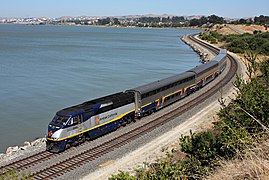
Capitol Corridor train in Amtrak California livery in 2011
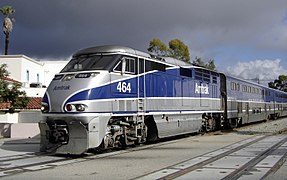
Pacific Surfliner train in 2006
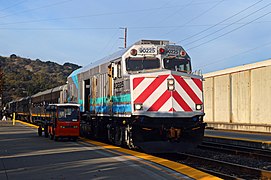
NPCU and Comet IB passenger cars in 2013
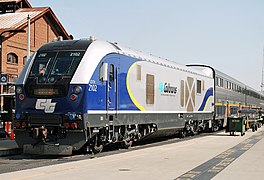
Charger SC-44 locomotive in Amtrak California livery in 2019

Charger SC-44 locomotive in Amtrak Pacific Surfliner livery in 2019
Amtrak Cascades[]
The Cascades service uses seven Talgo trainsets, F59PHI and Charger SC-44 locomotives, and ex-F40PH NPCUs painted in a brown, light tan, and dark green scheme - the only revenue equipment not painted in a blue-and-gray-based palette. The five older Talgo VI trainsets have the passenger cars split evenly between tan on top, brown in middle, and dark green on bottom. The transition baggage cars at the end have the green curve above the other colors, where it matches with a green curve on the older locomotives and NPCUs.[5][12]: 118, 140 The scheme was created by industrial designer Cesar Vergara, who also styled the GE Genesis locomotive.[21]
On the newer Charger SC-44 locomotives, the green stripe is narrower and runs along the top and over the cab.[22] One trainset was originally painted in blue, silver, and white for a Los Angeles-Las Vegas service that was never implemented.[23] In 2016, one NPCU, #90250, was wrapped in Seattle Seahawks livery for several months.[24] The newer Series 8 trainsets are painted similarly to the older sets. One end has a cab car, where the brown and green stripes come to a point, with the top of the cab also painted green.[25]

Cascades trainset with NPCU in 2006
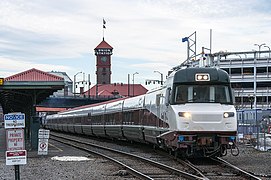
Cab end of a Series 8 trainset in 2012

Charger SC-44 locomotive in 2018
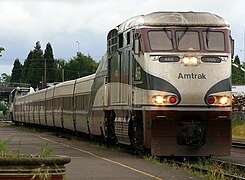
F59PHI locomotive in 2008
Amtrak Midwest[]
The Charger SC-44 locomotives used on the eight Amtrak Midwest routes (Hiawatha Service, Illini and Saluki, Illinois Zephyr and Carl Sandburg, Lincoln Service, Missouri River Runner, Wolverine, Blue Water, and Pere Marquette) have a blue front with a halftone transition into the gray side, with a red sill stripe.[26] Siemens Venture passenger cars under construction for the services will have a matching gray scheme with halftone blue transitions at the end of the window level, with a wider red sill stripe.[27]
Charger SC-44 locomotives in 2018
Piedmont[]
The state-owned equipment used on the Piedmont is painted in North Carolina state colors, with wide blue stripes on the passenger cars and blue fronts on the locomotives.[12]: 113

Piedmont train in 2016
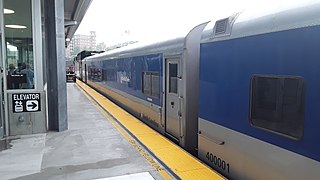
Piedmont refurbished passenger cars in 2019
Other routes[]
- From its 1974 introduction until 1977, the Adirondack used Delaware and Hudson Railway-owned equipment painted in the railroad's blue and gold scheme.[28]
- In the late 1990s, the Adirondack and the Vermonter each had a baggage car painted with a mural dedicated to the route.[12]: 104
- The single RTL Turboliner rebuilt in 1995 for the Empire Service had a one-off paint scheme with grey sides, a red stripe below the window, and white fronts.[12]: 150
- Two Talgo Series 8 trainsets were bought for use in Wisconsin on the Hiawatha Service, but never operated. They were painted white with red stripes to match the signature colors of the Wisconsin Badgers sports teams.[29][30]

Adirondack with Delaware and Hudson Railway equipment in 1974
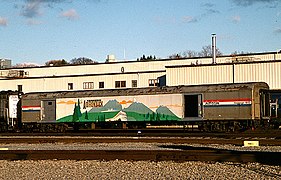
Adirondack baggage car in 2004

RTL-II trainset in 2006

Talgo Series 8 trainset in 2018
Special paint schemes[]
"Day 1" livery[]
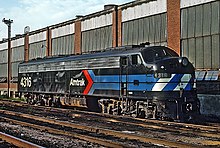
EMD E8 No. 4316 and coach 1589 were painted for display in New York when Amtrak began service in May 1971; they saw later use on the Broadway Limited. The locomotive was painted black; the Chevron "pointless arrow" logo on each side wrapped around the front with blue and white safety stripes.[31] Amtrak has retroactively referred to this paint scheme as the "Day 1" livery.[7]
40th anniversary heritage units[]
For Amtrak's 40th anniversary in 2011, the railroad painted four P42DC Genesis locomotives with special heritage unit liveries honoring the Phase I through Phase IV paint schemes. From January through April 2011, Amtrak's Beech Grove Shops outside Indianapolis repainted the units and sent them north on the Hoosier State to Chicago, where they were cycled into regular service on other routes. The Anniversary locomotives were selected from units scheduled for repainting or recent wreck rebuilds. The first repainted locomotive was No. 145 in Phase III paint, which led the Capitol Limited on January 30, 2011. Three other locomotives followed: Nos. 156 in Phase I, 66 in Phase II, and 184 in Phase IV.[32] P42DC No. 130 was painted in the Phase II livery after No. 66 was damaged beyond repair.[33]
The 40th Anniversary Exhibit Train consisted of P40DC locomotive No. 822, NPCU No. 406, modified Budd 10-6 heritage sleeper/Crew Dorm No. 10020 Pacific Bend, three heritage baggage cars used to house exhibits, and Amfleet cafe car No. 85999, used as a gift shop.[34] The whole train was painted in Phase III.[35]
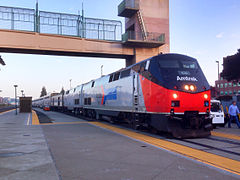
P42DC 156 in Phase I paint
P42DC 66 in Phase II paint

P42DC 145 in Phase III paint

NPCU 406 in Phase III paint

P42DC 184 in Phase IV paint
Veterans units[]
In June 2013, P42DC #42 was painted in a red, white, black, and dark blue scheme with a large logo on the side saying "America's Railroad Salutes our Veterans". A blue band near the wheelbase contains 50 white stars.[36] ACS-64 No. 642 and NPCUs Nos. 90208 and 90221 received similar paint schemes in 2015 and 2016.[37][38][39][40]
50th anniversary heritage units[]

On March 16, 2021, Amtrak announced the release of six heritage paint schemes, all with an "Amtrak 50" logo on the side, to be applied to five Genesis locomotives and one Charger ALC-42 locomotive. The liveries include heritage versions of the black "Day 1" livery on ALC-42 No. 301, a Phase I livery on P42 No. 161, a Phase III "Pepsi Can" livery on P42 No. 160, a Phase V livery on P42 No. 46, and a Phase VI livery on P42 No. 108 that is similar to the first ALC-42 units.[41] The sixth scheme was "Midnight Blue," a dark blue livery on P42 No. 100 celebrating employees who "keep passengers moving across the nation all throughout the night".[7][42]
Other special paint schemes[]
- The Amtrak California routes have wrapped locomotives to promote the Operation Lifesaver safety campaign. The decals featured bright designs with slogans about being safe around railroad tracks.[43][44][45][46]
- The first three ACS-64 units released from Siemens in 2013 had special decals applied. Locomotive Nos. 600 and 601 received a large American flag on the sides as well as smaller logos for Siemens & Amtrak.[47] Locomotive No. 602 had a "Reliability - Efficiency - Mobility" promotional graphic on the sides.[48] All three were later repainted with a conventional Phase V scheme before entering service.[49]
Non-revenue equipment[]
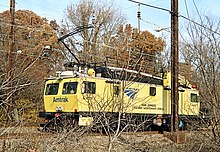
Beginning in 1976, Amtrak work train equipment was painted safety orange with black undersides. Light grey livery with a red bottom stripe, similar to Phase V non-passenger cars, was introduced for work train cars in 2004.[5] Safety yellow livery was introduced for maintenance of way equipment and roadway vehicles in 2001; it was replaced with a pale lime around 2004, and a brighter lime around 2013.[5] Non-revenue locomotives typically use variations of the Phase paint schemes to make them visually distinct from revenue locomotives while maintaining consistent styles.[5]
In 1997, Amtrak bought 50 rebuilt 50-foot (15 m) boxcars to supplement its newly built 60-foot (18 m) Express Box Car fleet. The rebuilt cars arrived in their original Southern Pacific Olive Green paint scheme, rather than the Phase V scheme of the newer cars, though some were later repainted.[50][51]
Advertising[]

Since the late 1990s, Amtrak has occasionally rented advertising space on the exterior of its passenger equipment. The ads sometimes take the form of wraps rather than true paint schemes. Customers have included fast food restaurants, auto manufacturers, television networks, and politicians.[52][53] In some cases, the advertisements were on equipment rented for private use, rather than on equipment in normal revenue service. Notable temporary advertisements have included:
- In 1999 and 2000, a four-car train including P42DC locomotive No. 100, a baggage car, a 1926 railway post office car, a business car, and an exhibit car was used for the United States Postal Service's "Celebrate the Century Express Educational Train Tour". The scheme consisted of a elaborate collection of enlarged stamps and postmarks from 1900 to the 1990s.[54]
- In October 2003, P42DC No. 203 and five Amfleet cars were wrapped in a scheme featuring Monopoly game pieces and money. The train was used as the "Reading Railroad", a special train from Chicago to Atlantic City, New Jersey upon which the first rounds of the 2003 U.S. National Championship were held.[55][56]
- In August 2004, presidential candidate John Kerry traveled on the "Kerry-Edwards Special", which used P42DC No. 138 wrapped with a "BELIEVE IN AMERICA TOUR" as the lead unit.[57]
- In November and December 2007, a full Acela Express trainset was wrapped to promote The History Channel's show 1968 with Tom Brokaw.[58] The wrap was criticized by passengers for impeding the view from inside the train. A similar wrap was used in 2010 to promote the TLC show Cake Boss.[59]
Test train schemes[]

Amtrak has tested a number of types of off-the-shelf equipment on the Northeast Corridor and short corridors. Some of these have been painted fully in Amtrak livery:
- Bombardier LRC cars received a variation of the Phase III scheme very similar to the RTL Turboliners.[12]: 154
- The Swedish Rc4 (numbered X995) and the French CC 21000 (X996), used for testing during the design of the AEM-7 locomotives in the late 1970s, used a Phase II scheme similar to the E60 locomotives the AEM-7 would replace.[60]

Other equipment largely retained their paint schemes from usage elsewhere:
- A Siemens ICE 1 trainset and a Kalmar Verkstad X2000 trainset were tested on the Northeast Corridor and several other routes in 1992 and 1993. The X2000 retained its Statens Järnvägar livery of silver with blue stripes, although it did receive Amtrak lettering; it was pulled by Amtrak diesels on non-electrified routes.[61][18]: 16 The ICE 1 retained its Deutsche Bahn livery of white with a two-tone red stripe, again with Amtrak lettering.[62] On non-electrified routes, it was pulled by two Siemens F69PHAC diesel locomotives painted in the same red-on-white scheme.[18]: 16
- After non-revenue testing on the Northeast Corridor in 1988, a Talgo 200 trainset was tested in revenue service between Portland and Seattle in 1994 as the Northwest Talgo.[63] The AVE paint scheme of white with a thick blue window stripe was modified with a thin Phase II red, white, and blue stripe below the windows.[64]
- In 1996, two Adtranz IC3 "Flexliner" trainsets were tested on several Amtrak routes in California, as well as the Metrolink Antelope Valley Line.[65][18] They retained their Israel Railways livery of white with red, black, and blue sections, with some Amtrak lettering added.[66]
References[]
- ^ Sanders, Craig (2006). Amtrak in the Heartland. Bloomington, Indiana: Indiana University Press. pp. 7–8. ISBN 978-0-253-34705-3.
- ^ "A Closer Look: Out on the Range". History Blog. Amtrak. December 15, 2014.
- ^ Kelly, John (June 5, 2001). "Amtrak's beginnings". Classic Trains Magazine. Retrieved December 29, 2010.
- ^ Franz, Justin (April 28, 2021). "It Takes a Lot of Thought and Planning to Paint a Train". Atlas Obscura.
- ^ a b c d e f g h i j k l m n o p q r s t u v w x y z aa "Official Paint Scheme and Logo Branding Guide" (PDF). Amtrak. February 2019. Archived (PDF) from the original on October 30, 2020.
- ^ "A Uniform Retrospective". Amtrak. January 30, 2014.
- ^ a b c d Donnelly, Matt (March 16, 2021). Amtrak 50th - Paint Scheme and Livery History (Video). Retrieved March 16, 2021.
- ^ "Prototype for the Adapted Phase I Livery". Amtrak.
- ^ Holland, Kevin J. (Spring–Summer 2009). "Amtrak's F40PH: From dark clouds, a silver lining". Railroad History (200): 59.
- ^ "Hot Line To President Boyd" (PDF). Amtrak News (September–October 1980). Amtrak. p. 10.
- ^ Solomon, Brian (2014). GE and EMD Locomotives: The Illustrated History. Voyageur Press. p. 130. ISBN 9780760346129 – via Google Books.
- ^ a b c d e f g h i j k Solomon, Brian (2004). Amtrak. Saint Paul, Minnesota: MBI. ISBN 978-0-7603-1765-5.
- ^ "Coming Soon: New Long Distance Cars". Amtrak. October 24, 2013. Retrieved February 26, 2018.
- ^ Gunnoe, Chase (January 12, 2016). "Amtrak confirms 'Phase III' scheme for 'Empire Service' locomotives". Trains. Retrieved January 13, 2016.
- ^ Simon, Elbert; Warner, David C. (2011). Amtrak by the numbers: a comprehensive passenger car and motive power roster, 1971-2011. Kansas City, Missouri: White River Productions. p. 7. ISBN 978-1-932804-12-6.
- ^ "Amtrak Prepares for New Diesel Locomotive Fleet: Transitional paint scheme on the first ALC-42 Siemens Chargers" (Press release). Amtrak. August 2020.
- ^ "News Release: Siemens Charger Clean Diesel-Electric Locomotives to Begin Operation on Capitol Corridor this Month" (Press release). Capitol Corridor Joint Powers Authority. April 18, 2017.
- ^ a b c d Vurek, Matthew Gerald (2016). Images of Modern America: California’s Capitol Corridor. Arcadia Publishing. pp. 16, 30, 68. ISBN 9781467124171.
- ^ "New, Cleaner Locomotives Coming Soon to the Amtrak Pacific Surfliner Service" (Press release). Amtrak. October 5, 2018.
- ^ "Amtrak's Pacific Surfliner Celebrating Ten Easy Going Years" (Press release). Amtrak. June 3, 2010. Archived from the original on September 23, 2010.
- ^ Gormick, Greg (November 21, 2005). "High style, high tech; Putting style back on track". Toronto Star. p. D01. ProQuest 438900729.
- ^ Chirls, Stuart (March 9, 2017). "Siemens turns out first WSDOT Charger". Railway Age.
- ^ "L.A.-Vegas high-speed train set for debut". Las Vegas Sun. July 18, 1999.
- ^ "New Seahawks-themed Amtrak Cascades train debuts in Seattle" (Press release). Washington State Department of Transportation. October 12, 2016.
- ^ "ODOT Purchases Talgo Passenger Trains" (Press release). Talgo America. February 26, 2010.
- ^ "New Locomotives Serving Amtrak Customers on State-sponsored Trains in the Midwest" (Press release). Amtrak. August 28, 2017.
- ^ Luczak, Marybeth (January 26, 2021). "Watch: Amtrak Midwest Siemens Ventures (Updated)". Railway Age. Retrieved March 16, 2021.
- ^ "Celebrating 40 Years of the Adirondack". Amtrak. August 5, 2014.
- ^ Nolan, Kay (September 9, 2010). "Talgo trains to sport Badger colors, traditional locomotives". WisBusiness.
- ^ Ryan, Sean (September 26, 2016). "Talgo will return to Milwaukee to refurbish trains for Los Angeles". Milwaukee Business Journal.
- ^ Phillips, Don (July 22, 2011). "The Road to Rescue" (PDF). Classic Trains. pp. 22–31. Archived from the original (PDF) on September 1, 2016. Retrieved March 20, 2017 – via Northwestern University Transportation Center.
- ^ "Amtrak Locomotives" (PDF). Amtrak. 2011. Archived from the original (PDF) on September 1, 2017.
- ^ Sanders, Craig (April 12, 2018). "Amtrak P42 No. 66 Back in the Day". Amtrak in the Heartland.
- ^ "Exhibit Train Equipment History". Amtrak. Archived from the original on April 30, 2011. Retrieved June 5, 2011.
- ^ "New England Transit News". Rollsign. Boston Street Railway Association. July–August 2017. p. 9.
- ^ "Amtrak Salutes Our Veterans: Custom painted locomotive honors those who have served" (PDF). Amtrak Ink. Vol. 18 no. 6. July 2013. pp. 10–11.
- ^ "Amtrak Commissions New Veterans Locomotive" (Press release). Amtrak. June 29, 2015.
- ^ "Second Amtrak veterans' locomotive in-transit to Northeast". Trains Newswire. May 18, 2015.
- ^ Equipment Capital Subcommittee of the Next Generation Equipment Committee (October 27, 2015). "Capital Investment Plan for Amtrak Equipment Deployed in State Corridor Service FY2016 – FY2020" (PDF). Front cover.
- ^ Moser, Emily (September 15, 2016). "AMTK 90221 Amtrak NPCU at Beech Grove, Indiana". RailPictures.Net.
- ^ "A Brief History of Amtrak Paint Schemes and Liveries". Amtrak. Retrieved July 26, 2021.
- ^ Johnston, Bob (March 18, 2021). "Behind Amtrak's new locomotive designs". Trains. Retrieved March 31, 2021.
- ^ Farago, Zoltan (January 9, 2009). "AMTK 455 Amtrak California EMD F59PHI at San Diego, California". RailPictures.Net.
- ^ Swegles, Fred (November 11, 2008). "Slide show: Coastal Trail is improving safety on rails, San Clemente says". Orange County Register.
- ^ Welch, Steven M. (November 16, 2010). "CDTX 2007 Amtrak California EMD F59PHI at Oakland, California". RailPictures.Net.
- ^ Walker, Craig (December 4, 2011). "AMTK 457". RR Picture Archives.
- ^ "New Amtrak Locomotives: The Facts" (Press release). Amtrak. February 2014.
- ^ Margherone, Ben (June 27, 2013). "Martinez 6/27/13 w/a new ACS-64 & NPCU". RailPictures.Net.
- ^ Tempera, Jacqueline (February 7, 2014). "First of new Amtrak locomotives launches in Boston". Boston Globe.
- ^ "Amtrak builds non-passenger revenue". Railway Gazette. July 1, 1998.
- ^ "The Express Box Cars". Amtrak Photo Archive: an unofficial amtrak site. Retrieved March 21, 2017.
- ^ Cassidy, Martin B. (October 3, 2010). "Trains could become major advertising platform". Stamford Advocate. Retrieved March 20, 2017.
- ^ "Toyota takes to Amtrak tracks for ad campaign". Destination:Freedom. Vol. 5 no. 46. National Corridors Initiative. December 6, 2004. Archived from the original on April 6, 2006. Retrieved March 20, 2017.
- ^ "All Aboard! Celebrate The Century Express Education Train Tour" (PDF). USPS. May 18, 2000. pp. Page 1 of 104. Archived from the original (PDF) on May 9, 2009. Retrieved March 25, 2009.
- ^ Davidowitz, Aron (October 16, 2003). "Monopoly tournament beckons". Baltimore Sun. Retrieved March 20, 2017.
- ^ Orbanes, Philip E. (2007). Monopoly: The World's Most Famous Game -And How It Got That Way. Da Capo Press. p. 155. ISBN 9780306815928 – via Google Books.
- ^ Appleman, Eric M. (2004). "John Kerry's Post-Convention Tour". Democracy in Action. George Washington University.
- ^ "Amtrak Acela Express Wrapped for The History Channel® Promotion for Special "1968 with Tom Brokaw"" (Press release). Amtrak. November 6, 2007.
- ^ "Amtrak Wraps Acela Express With Image Of TLC "Cake Boss" Buddy Valastro" (PDF) (Press release). Amtrak. August 2, 2010.
- ^ "Amtrak No. X995 test locomotive, late 1970s". Amtrak. June 13, 2013.
- ^ "X2000 in the Chicago Yards, 1993". Amtrak History Archives. Amtrak. June 24, 2014.
- ^ "Intercity Express in Connecticut, 1993". Amtrak History Archives. Amtrak. May 3, 2011.
- ^ "History: Talgo North America". Talgo America. 2015.
- ^ Hulin, Gil (June 1994). "GO WEST - or whatever - for S" (PDF). Dispatch. Vol. 18 no. 3. National Association of S-Gaugers. p. 16.
- ^ de la Loz, James L. (May 30, 1997). "SUMMARY OF ALTERNATE RAIL TECHNOLOGY (ART) ANALYSIS" (PDF). Los Angeles County Metropolitan Transportation Authority. p. 9.
- ^ "Expediter". Pacific RailNews. No. 394. September 1996. p. 8.
External links[]
![]() Media related to Amtrak paint schemes at Wikimedia Commons
Media related to Amtrak paint schemes at Wikimedia Commons
- Amtrak
- Amtrak rolling stock




























